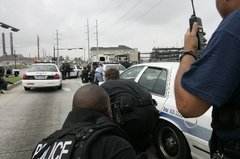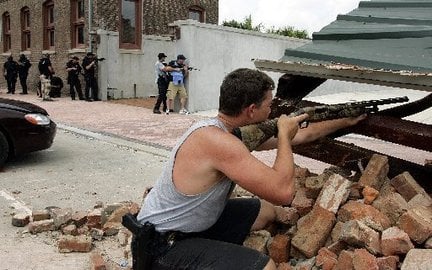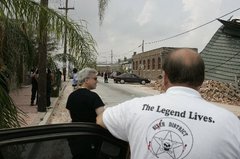A motionless body lay on the pavement. Perhaps 20 riled-up police officers milled around. On the shoulder of the road, an RTA bus was parked at a crazy angle, like a dislocated elbow. Nearby was a long white limousine, crashed into a pole.
What had we stumbled upon?
Then there were guns aimed at us, and my face was pushed against a wall. I heard lots of shouting and cursing.
It was three days after the levees broke: Thursday, Sept. 1, 2005 — in my limited view, the day things completely fell apart in New Orleans.
The desperation was mounting. The cavalry wasn’t coming, it seemed. We were in it alone.
The heat was brutal, punishing. Supplies were minimal, and shrinking.
I had been riding around town with Marko Georgiev, a freelance photographer for The New York Times. It was a symbiotic relationship: He needed a roof over his head and a local guide. I needed a working vehicle and, as it happened, survival skills.
We spent part of the day reporting from the Superdome, and after we left we drove by the Convention Center, by then a scene of privation and anger. Crowds were spilling into the street. It was hard to do anything but creep along slowly. Georgiev spotted a young guy taking pictures of the misery and decided the guy was going to get hurt. He barked at the kid to get in the car.
Once our passenger was aboard — I never did hear his name — we headed uptown toward my house, about three miles away, thinking we’d try to file some stories and pictures. My landline, luckily and strangely, had never stopped working.
As we drove up Religious Street, just past the Saulet Apartments, we saw a dicey situation ahead. Police-issue Crown Victorias blocking the intersection. A parked bus and a wrecked limo. And a swarm of police officers in the street, guns drawn, facing the other direction.
Georgiev, a Macedonian national who has spent much of his life covering wars, went into gung-ho mode. He took a right — toward the lake — on Race Street. Then left at the next block, St. Thomas Street. Then left again on Richard. And suddenly, we were right in the middle of chaos.
We saw a man, clad in a white T-shirt, down on the pavement, hands behind his back, not moving. We were both sure he was dead. A lot of agitated police officers hovered around.
It seemed no one noticed, though we were less than 50 feet away. Georgiev shot off a few frames, then started to drive away. As he passed through the intersection, the cops yelled at us to stop. Some had their guns raised. I shouted to stop, and Georgiev did, not as quickly as I would have.
A few cops rushed over and stuck their guns in our faces. I said I worked for the Picayune. I was told to shut up and get out.
They threw us up against a cinderblock wall and frisked us. There was a lot of cursing, and one of the officers mentioned a shootout.
One of the cops grabbed the notebook out of my shorts. They also snatched one of Georgiev’s cameras.

After a couple of minutes, the cops told us to leave. One of them skidded Georgiev’s camera back to him from across the street, like he was bowling. I still didn’t have my notebook and argued that they needed to give it back. I was told, again, to leave.
I took a quick peek around and saw my notebook on the back bumper of our SUV. I grabbed it, and off we went.
Georgiev looked at his camera and said his memory card containing most of his work from the day was gone. But he had shot the Religious Street incident with a different camera — he still had those photos.
We asked our passenger where he lived — it was not far away — and we dropped him off.
Later that day, I filed a story online about what I had seen, most of it involving the Superdome. This is what I wrote about the incident on Religious Street: “Near the former St. Thomas housing development, a squadron of police, some in tactical gear, were clustered in an intersection. A Regional Transit Authority bus was nearby, and a man who appeared to be dead from a gunshot wound lay on the ground.
“It was unclear what had occurred. Police said there had been a shootout as they forced a reporter and a photographer out of a passing car at gunpoint, pushing them face first against the wall. They took away a reporter’s notebook and tossed the photographer’s camera on the ground before returning them and telling the pair to leave.”
Maybe a month later, a police reporter at the newspaper talked to some NOPD officers he knew, and they told him the guy we had seen wasn’t dead.
We had no proof that he was — we just thought he was based on the confluence of circumstances. And there was no autopsy of a dead man who seemed to match our situation, though the cataloguing of the dead was hardly done in a way that inspired confidence.
I put the Religious Street incident away, chalking it up to the fog of Katrina and figuring I would never know what really happened.
But it’s never stopped bothering me, and now, with federal grand juries investigating the actions of police after Katrina — the Danziger Bridge shootings, a burned body in a car in Algiers, perhaps other incidents — it’s been weighing on my mind more heavily.
Who was that guy? What happened to him? Is he alive and well, and living in Houston or in the Sixth Ward? Or did he die anonymously, with Georgiev there to chronicle it? Did anyone ever write up a police report or attempt to account for what happened?
Lying in the weeds
A few months ago, I reached out to Georgiev, who lives in Macedonia, and he sent me two photos of the incident. A closer look at them reveals that there seem to be two guys on the ground, not one. Georgiev’s second shot shows a human form in the street, next to one of the police cars, wearing a red shirt and hidden behind weeds.
As it happens, the existence of a second person squares with the only official account of the incident I’ve been able to get thus far. That account came from Anthony Cannatella, a semiretired deputy chief with 42 years on the force who during Katrina was the commander of the 6th District, where the incident happened.
Cannatella — to his credit, one of the only officers who will talk about any of this — was one of the cops who responded, though I didn’t see him that day. As Katrina descended, Cannatella says he told “his guys” this: “We’re gonna do basic police work until someone comes and relieves us.”

Without communication, he adds: “We were functioning as an independent police department because we didn’t know where NOPD was,” meaning central command. One of the few directives that did come down from the brass was that police reports would be unnecessary.
The Religious Street incident started, Cannatella says, when one of his men, Fred Fath, got on the radio and said he was being shot at near Race and Religious streets at a limousine-rental place where a break-in had been reported.
Fath remembers that when he and his partner for the day — “Joey,” Fath can’t recall his last name — arrived at the limo place, they were directed by someone to the brick-and-glass building on the corner of Religious and Race streets, now home to the Monkey Room, a children’s playspot.
Fath says he used the butt of his gun to break the glass to get inside. When he did, someone fired a couple of shots back at him from inside, breaking the rest of the glass. He fired the shotgun once into the building, blindly, and he and his partner took cover behind the brick portion of the wall.
Fath quickly retreated to his squad car, getting behind the engine block. He shouted to his partner to run at the count of three, promising to cover him. When Fath counted three, a couple more shots rang out. Fath and his partner waited for backup.
Fath put out a 108 call on his radio, saying an officer needed assistance. On a 108 call, policy says that the district cops set up a perimeter and call for the SWAT team.
As Cannatella and his men set up a perimeter, SWAT guys started to arrive, he remembers. Alex Brandon, then a Times-Picayune photographer, was with them. He shot a picture of Fath in position, rifle on his shoulder, that was published in the newspaper and in National Geographic.
But when the order came down to enter the building, the 6th District cops and the SWAT guys didn’t find anything, both Cannatella and Fath say. Capt. Michael Glasser, the head of the Police Association of New Orleans, was also called to the scene; he had a similar account of the SWAT roll.
Seizing on two suspects
Shortly after the SWAT raid, Cannatella says, a call had come over the radio from a couple of 2nd District cops, who said they had detained two men just up the street who had stolen a limo. The police found no guns on them. Still, Cannatella figured they were the ones who shot at Fath; they had probably ditched their weapons by the time they were stopped.
Cannatella said he walked over to the scene and yelled at one of the two guys, who was on the ground: “Why were you shooting at cops?” The guy said he didn’t do anything.
In the end, Cannatella said he told the two 2nd District cops to book the two men with car theft. “I’m not gonna bum rap anyone,” he told me. “We didn’t find any guns or weapons and could not make a case they fired a gun at anyone.”
Later, Cannatella said, he found out there was no lockup, so he suspects — though he doesn’t know for sure — that the 2nd District cops just took down the guys’ names and let them go. He doesn’t know the officers’ names. No one else seems to know, either. When I asked Eddie Hosli, the 2nd District commander during Katrina, about the arrest of two limousine thieves by a couple of his men, it didn’t ring any bells.
Cannatella says he was at the scene for perhaps 10 minutes, tops. He recalls that “a bunch of guys,” apparently us, got out of a vehicle and started walking toward the scene taking pictures. He remembers the vehicle to have been a van, though we were riding in an SUV. He was worried some of the cops, who “challenged” the journalists, were going to hurt them, and he told them to lay off. Some of the cops were from the flooded 3rd District, and Cannatella says he told them to get lost.
Though he wasn’t there when the two suspects on the ground were stopped, Cannatella says he’s sure nothing untoward happened to them.
He allows it’s possible the two suspects were roughed up, but he says they both looked him in the eye when he approached, and at least one of them was able to speak.
 He said he asked his officers whether they fired their weapons at any point, and they all said no. “They’d have told me,” he said. A cover-up, he said, is outside the realm of possibility.
He said he asked his officers whether they fired their weapons at any point, and they all said no. “They’d have told me,” he said. A cover-up, he said, is outside the realm of possibility.
While it drew a raft of cops to the Lower Garden District, the incident does not appear to have resulted in any paperwork, which was not unusual in the chaotic environment after the storm. Requests to the NOPD for such materials have turned up nothing.
Strangely, Fath, who by both his own account and that of Cannatella could easily have been killed that day, said he didn’t know that anyone was ever arrested or detained in connection with the incident until I told him about it recently. This even though the two crime scenes — the place where he was shot at, and the intersection where the suspects were detained — were perhaps 200 yards apart.
Elusive truth
That raises one of several questions that still bother me, more than four years later:
Why did the guy we could see appear to be dead?
Would the police simply release two men who they believed had been shooting at officers at close range just minutes earlier?
Last, and most troubling, why — if the police were doing terrific work, as Cannatella says — did they hustle us out of the car and take Georgiev’s camera? Why not parade the perpetrators before the photographer and explain how they caught these guys looting and shooting at cops?
There’s a flip side too, though. If this was a cover-up, for instance, and the men were shot, why is there so little blood on the man’s white T-shirt? Is it even possible to cover up an incident witnessed by so many cops?
It turns out I’m not the only one who wondered what happened. The district attorney’s office was also sufficiently troubled by the photo and the cops’ behavior that investigators made at least a cursory attempt in 2006 to find out more. A document shows the DA’s investigators were trying to identify officers in the picture, and a source familiar with the DA’s probe says the office requested a police report about the incident but was told that none existed.
For his part, Cannatella doesn’t defend the frisking and the confiscation of the camera memory card. But he says the cops who did that were from another district, probably the 3rd, and he doesn’t know what they were thinking.
The only guys Cannatella recognizes in the pictures of the scene are Kendrick Bankston and Jon Hartman, both of whom worked in the 6th. Neither works for NOPD these days. Bankston, who lives in Texas, said he didn’t remember anything about the incident, even after reviewing pictures of it. Hartman, who has relocated to California, likewise remembered little — other than what Cannatella told him in a recent conversation — but he is sure that no one was killed.
Attempts to identify the other offices in the pictures have been mostly unsuccessful. But several officers have picked out Donald Clogher, who was posted to the 3rd District during Katrina and who has since left the NOPD and joined the Jefferson Parish Sheriff’s Office.
Reached by phone, Clogher also said he remembered little if anything from the incident. He said he had responded to the 108 call, but didn’t recall if there had been a shootout. He said he did not know the condition of the men on the ground.
“We were ordered from the scene,” he said. “I have no direct knowledge of what happened.”











